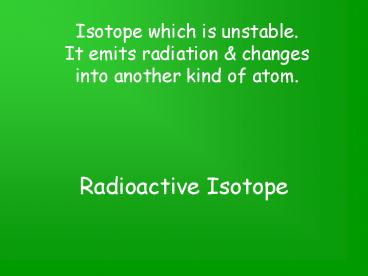Radioactive Isotope PowerPoint PPT Presentation
1 / 36
Title: Radioactive Isotope
1
Radioactive Isotope
- Isotope which is unstable. It emits radiation
changes into another kind of atom.
2
Transmutation Reaction
- When one kind of nucleus changes into another
kind of nucleus.
3
Relationship between stability and energy
- As stability ?, energy ?.
4
Stability
- Depends on neutron to proton ratio.
5
Which elements are unstable?
- All the elements with atomic number gt 83 (or
beyond Bismuth)
6
Types of Radiation
- Alpha, Beta, Gamma
- Separated by electric or magnetic fields.
7
Least penetration power
- Alpha radiation. Shielding can be paper or cloth.
8
Most penetration power
- Gamma radiation. Requires lead/concrete
shielding.
9
2He or 2?
- Symbol for alpha radiation
4
4
10
2He or 2?
- Same as the nucleus of a helium atom
4
4
11
2He or 2?
- Mass 4 amu
- Charge 2
4
4
12
-1e or -1? or ?- or ?
- Symbol for beta particle
0
0
13
-1e or -1? or ?- or ?
- Fast moving electron originating from nucleus
0
0
14
-1e or -1? or ?- or ?
- Mass zero
- Charge -1
0
0
15
1e or 1? or ?
- Symbol for positron.
0
0
16
1e or 1? or ?
- Mass zero.
- Charge 1.
- Positive electron
0
0
17
0? or ?
- Symbol for gamma radiation.
0
18
0? or ?
- 0 mass
- 0 charge
0
19
0n or n
- Symbol for neutron
1
20
1H or 1p
- Symbol for proton
1
1
21
Alpha Decay
- Unstable nucleus emits an alpha particle. Atomic
? by 2. Mass ? by 4.
22
220Fr ? 4? 216At
- Unstable nucleus emits an alpha particle. Atomic
? by 2. Mass ? by 4.
2
85
87
23
220Fr ? 4? 216At
- Equation represents natural transmutation.
- 1 term on reactant side.
2
85
87
24
220Fr ? 4? 216At
- Balance nuclear equations using conservation of
atomic number conservation of mass number.
4 216
220
2
85
87
2 85
87
25
of Half-Lives
- Elapsed time
- Length of H.L.
26
Half-Life Map
Mass Elapsed Time Fraction Remaining of Half Lives
Start mass 0 1 0
1 X H.L. ½ 1
2 X H.L. ¼ 2
3 X H.L. 1/8 3
4 X H.L. 1/16 4
27
Decay Mode
- Same as type of particle emitted
28
Average Atomic Mass
- Weighted average of the masses of the naturally
occurring isotopes.
29
Artificial Transmutation
- Particle bullet hits target nucleus new
isotope is produced. - 2 terms on reactant side.
30
Artificial Transmutation
bullet
target
- 32S 1n ? 32P 1H
1
16
0
15
31
Artificial Transmutation
- Particle bullet may be proton or alpha
particle. To react with a nucleus, must overcome
repulsive forces by accelerating bullet to
high speeds. - Particle bullet may be a neutron. Neutrons
have no charge, so no repulsive forces to
overcome. No acceleration necessary.
32
Fission
- Fission is division.
- Large nucleus (U-235 or Pu-239) is split into 2
medium sized nuclei by a neutron bullet. Excess
neutrons a great deal of energy are also
produced.
33
239Pu 1n ? 90Sr 147Ba 3 1n
- Fission
94
0
0
38
56
34
Fusion
- Fusion U for unite and U for sun.
- Very small nuclei (H He) are jammed together.
Huge amounts of energy are released.
35
1H 2H ? 3He
- Fusion
1
1
2
36
Identify each of the rxns
fission
- 1n 235U ? 142Ba 91Kr 3 1n energy
- 59Co 1n ? 60Co
- 3He 1H ? 4He 0e
- 14C ? 14N 0e
0
92
56
36
0
Artificial transmutation
27
0
27
fusion
1
2
2
1
Natural transmutation
6
7
-1

